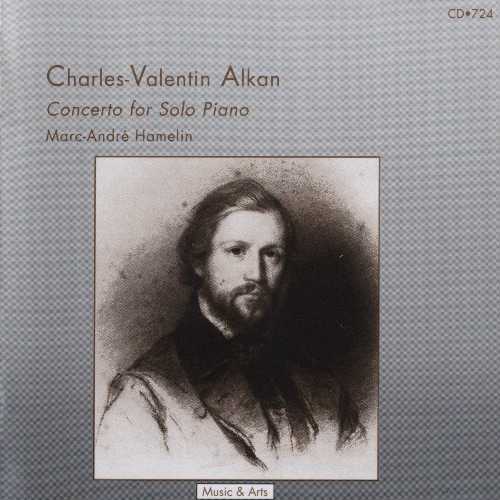
Performer: Marc-Andre Hamelin
Composer: Charles-Valentin Alkan
Audio CD
SPARS Code: DDD
Number of Discs: 1
Format: APE (image+cue)
Label: Music & Arts Program
Size: 186 MB
Recovery: +3%
Scan: yes
1. Allegro assai
2. Adagio
3. Allegretto alla barbaresca
Concerto, for solo piano in G sharp minor (?tudes dans tous les tons mineurs Nos. 8-10), Op. 39/8-10
Composed by Charles-Valentin Alkan
with Marc-Andre Hamelin
A “Forgotten Masterpiece” and a Clumsy Performance
Alkan’s Concerto for Solo Piano Op. 39 is one of the greatest masterpieces of the Romantic piano literature and yet it is a victim of a horrible crime: neglect. Charles-Valentin Alkan, who is surely the most enigmatic composer in music history, was respected, admired, and even feared by his contemporaries. Anton Rubinstein had great admiration for Alkan and even dedicated his Fifth Piano Concerto to him. Hans von Bülow gave Alkan the famous appellation, “Berlioz of the piano.” Franz Liszt thought Alkan’s piano technique superior to his own and according to David Dubal, Liszt “once said that he was never nervous playing for anyone but Alkan.”
The tragedy about Alkan’s life and legacy is that, although he was esteemed by Chopin and Liszt, his compositions were totally ignored. Beyond that, his music had the reputation of being “bizarre and unplayable.” It wasn’t until Ferruccio Busoni and Egon Petri that Alkan’s works found worthy champions. Busoni believed Alkan to be, like Chopin, Schumann, Brahms and Liszt, one of the greatest post-Beethoven piano composers. I am in the Busoni camp completely, especially after traversing so much of Alkan’s music. The gigantic Concerto for Solo Piano of the Op. 39 Etudes deserves a place next to the other large-scale piano “greats”: Beethoven’s Hammerklavier and Liszt’s Sonata in B minor. Alkan’s entire Op. 39 is arguably one of the most original set of Etudes of all time. But Alkan’s three movement Concerto is the crowning achievement of this set. The Concerto possesses all the traits of a normal piano concerto: tuttis and solos, lines for each instrument, an orchestral introduction, cadenzas… and yet Alkan refuses to enlist the aid of the orchestra in expressing this colossal music; he bravely challenges the edges of solo instrumental technique with only his beloved keyboard as his weapon.
It’s necessary for the reader to understand that I adore Alkan and this particular work, but I must sadly give this particular recording three stars for the disastrous and lackluster performance by Marc-Andre Hamelin. This is the only Alkan recording that he has failed to deliver with his customary arsenal of superlative virtuosity, interpretative insight *and* emotion. The first movement is a musical canvas of epic brushstrokes and details of Romantic expression, but Hamelin chooses to approach this grand movement as if it was a Handel suite. The warm legato, sonorous turbulence and Romantic fire that Alkan’s must needs in order to speak to us is absent in Hamelin’s performance. In the second movement, a lamenting and sublimely beautiful work, Hamelin has neither rich articulation nor passion in his phrasing. The last movement fairs a little better, but although Hamelin’s tempo and flawless virtuosity are awe-inspiring, he doesn’t summon the drama and swelling dynamics that this movement needs. It saddens me to speak so harshly about Hamelin, a pianist whom I consider myself to be a fan of! He has outstripped every other performer when it comes to Alkan’s other works like the Symphony for Solo Piano and the Grande Sonate. But his decision to play the Concerto for Solo Piano as if it were a Mozart piano concerto, full of an overwhelming and incessant staccato touch, does a disservice to this masterpiece of the piano literature.
Bottom line: In this Concerto, the sweeping crescendi and roaring fanfares that should stimulate goose bumps are merely mechanical arpeggios in Hamelin’s hands. I am hopeful for Hamelin after reading in Hyperion’s catalogue that he is recording the Concerto again. Perhaps he will redeem himself, but until then, I must whole-heartedly direct the reader to Jack Gibbons’ interpretation and sublime delivery of the Concerto for Solo Piano: (Alkan: 12 Études, Op. 39). Gibbons’ powerful rendition of the Concerto Op. 39 is vastly superior to Hamelin’s schizophrenic excursion. The Gibbons recording also contains even more of Alkan’s music and some great interpretations of them. However, since I don’t expect anyone to take my word for it, I encourage buying both CD’s and making one’s own judgment.
Alkan and Hamelin Redefine Pianism
There simply cannot be enough praise for this extraordinary recording of one of the most unfairly neglected masterpieces of music of all time. I do not want to undermine my writing with exaggerated use of superlatives–which anyway would not be capable of describing this strangely hidden treasure of priceless music and pianism. What Hamelin actually manages to accomplish with his only ten fingers is beyond reproach.
Pick any pianistic feature or trick–you will find them all in Alkan’s masterpiece, executed by Hamelin to a degree of perfection most other pianists could only equal in their dreams. His absolute command and natural fluency of the music is not likely to be surpassed in the foreseeable future.
Indeed, Gibbon’s ASV or Smith’s EMI versions may well be worth acquiring–not for comparison, which simply would not make much sense, but for a better recorded piano sound. That is namely my only reservation about this disc–the fact that the recorded sound of the, alas, Yamaha instrument is terribly boxy and unnatural.
On this near 50-minute disc, Alkan and Hamelin redefine the notion of pianism–that is, what is physically possible to achieve, given one piano and two hands. I cannot see what could replace this desert island record, other than a Steinway/Hyperion remake in opulent sound.
APPENDIX: Since Hamelin’s remake of the Alkan Concerto was released by Hyperion in September 2007, this desert island disc has indeed effectively been replaced. The remake not only features vastly superior near-demonstration sound but also greater delicacy and refinement.
Incendiary piano playing
This astonishing performance is the one that first brought the playing of Canadian super-virtuoso Marc-Andre Hamelin to my attention. In the years since then I have purchased just about everything he has recorded, and heard him play five recitals, one of which featured the Alkan Concerto.
If you have never heard this piece you owe it to yourself to do so. The first movement alone is one of the most unusual and fascinating things I know from the earlier half of the nineteenth century. Cast in alternating ‘orchestral’ and ‘solo’ passages like a piano concerto, it is a gigantic work of relentless pianistic fireworks. To see it on the printed page is eye-popping and to hear it played is absolutely hair-raising. There have been previous magnificent readings of this music, by pianists such as John Ogdon and Ronald Smith, but Hamelin easily surpasses them in his command of the architecture of the piece, in the clarity and dryness of his articulation, the unbelievable ease with which he tosses off supremely difficult and thick figurations, and the scorching, almost diabolical energy he produces on every page.
This is truly one of the great piano recordings of all time. If you love fantastic piano playing, make certain to add this to your library.
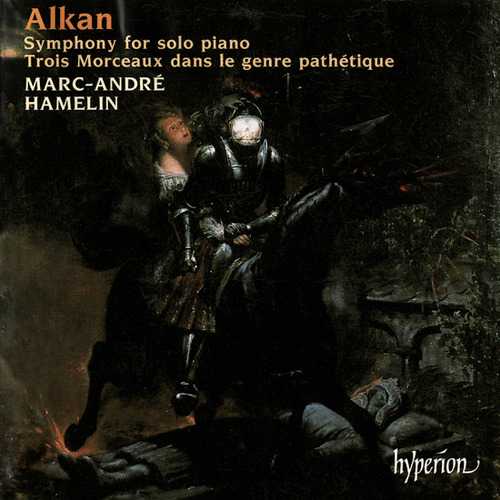
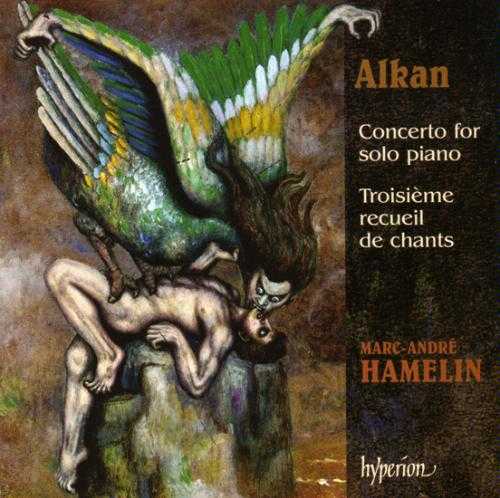
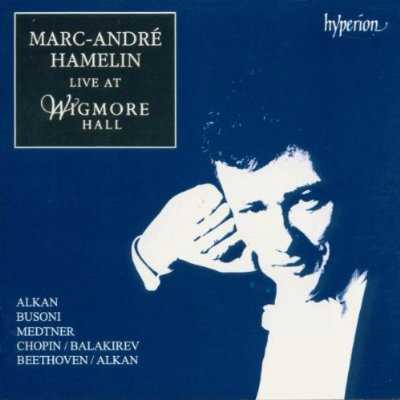
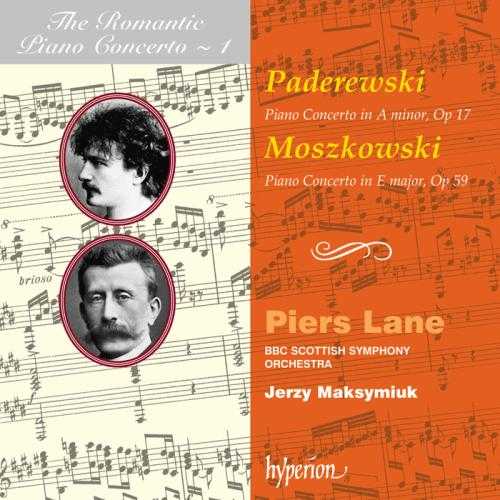
Thanks very much :-)
whow, not only a great pianist but also a great composer, i became acquainted with by your posts. i enjoyed this concert very much – an even more the 12 etudes (your other post). now the concerto etc. you posted in april 2012 is waiting. – by the way the earlier posts of april 2011 are no longer available – is there any chance ?
i’ve to say thank you again, i think you are one of my most important music-teachers.
Hamelin one of my favs ¡¡ thanks a lot¡¡
Fantastic! I had the pleasure of seeing Marc-Andre Hamelin in concert and I feel he is our finest living pianist.
Thanks